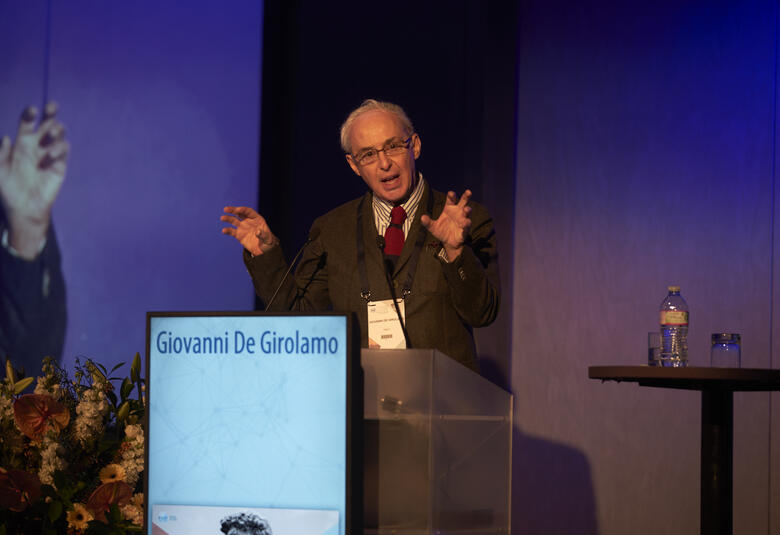Reduced anatomical and functional connectivity in relevant neural pathways is associated with cognitive and psychomotor symptoms in schizophrenia. But, despite the wealth of imaging studies, evidence that these abnormalities exist in at-risk individuals prior to first episode psychosis and its subsequent treatment is still incomplete.
The idea that the underlying problem in schizophrenia lies in disrupted communication between multiple, functionally-related brain regions is not new. What is new is our ability to investigate the hypothesis using increasingly sophisticated imaging techniques and data analysis.
In 1999, Nancy Andreasen argued that schizophrenia symptoms can be traced to aberrations in cortical-thalamic-cortical circuitry that prevent the synchronisation and smooth co-ordination of mental processes: the concept of cognitive dysmetria.
At the EPA in 2016, Gerd Wagner (University Hospital of Jena, Jena, Germany) presented new data to support the concept. The studies in which he is involved have used functional magnetic resonance imaging (fMRI) and diffusion tensor imaging to relate fronto-thalamic disconnectivity to cognitive control of executive function in patients with schizophrenia.
Using the Stroop task, the study compared reaction time and functional and structural imaging data in 30 patients and forty matched, healthy controls. Relative to controls, patients showed significantly lower activation in fronto-thalamo-cerebellar circuitry. There was also evidence of lack of interhemispheric connections.
Linking patterns of temporal activation
In a somewhat larger study (71 patients and 196 healthy controls), Tobias Kaufmann (Oslo University Hospital, Norway) and colleagues estimated the strength of functional connectivity by assessing the extent to which different brain regions showed similar patterns of temporal activation.
The strongest sign of reduced functional connectivity in patients came from the sensorimotor and sensorimotor-thalamic networks. Differences between patient and control groups were robust and consistent when assessed using various cognitive tasks. But Dr Kaufmann admitted that we cannot yet exclude the possibility that such differences arise not from the disease itself but from its therapy.
It is important to note that the patients concerned had chronic schizophrenia and had spent an average of almost ten years on treatment.
Cause or consequence?
Stefan Borgwardt (University of Basel, Switzerland) argued that we now have at least some evidence that differences in connectivity -- between the frontal and parietal regions, for example -- predate the onset of psychosis in high-risk individuals. Although the number of subjects was admittedly small (twenty healthy controls, 17 people at high risk of psychosis, and twenty with FEP), an fMRI study conducted while subjects performed a working memory task suggested a progressive reduction in the integration of the brain areas involved in cognitive processing.
This association between vulnerability to psychosis and abnormal fronto-parietal connectivity has been complemented by work linking connectivity to symptoms. In a study comparing healthy controls against people with at-risk mental states who were antipsychotic-naive, the degree of connectivity was negatively correlated with total score on the Brief Psychiatric Rating Scale.
Furthermore, Borgwardt et al suggest, this connectivity deficit can be reduced by administering low-doses of antipsychotics.
Need for further studies
However, the overall situation in the connectivity field remains complicated. Certain studies are conducted in people at-risk, others in those with FEP, and others in patients who already have a diagnosis of schizophrenia.
These populations are not necessarily made up of people at different stages in an inevitable disease process. Many of the vulnerable do not develop psychosis. And perhaps a quarter to one third of those with FEP never progress to a diagnosis of schizophrenia.
Though evidence is mounting that disordered connectivity is present prior to full-blown schizophrenia, definitions of “high risk” differ; and the natural history of the prolonged prodromal or transitional phase varies between patients from being virtually asymptomatic to brief periods of frankly psychotic symptoms that spontaneously remit.
We will better understand whether schizophrenia is truly in essence a neurodevelopmental disorder only when we have more extensive longitudinal studies, and when we are able to map variants in putative susceptibility genes such as DISC1 to early signs of abnormal brain connectivity.



